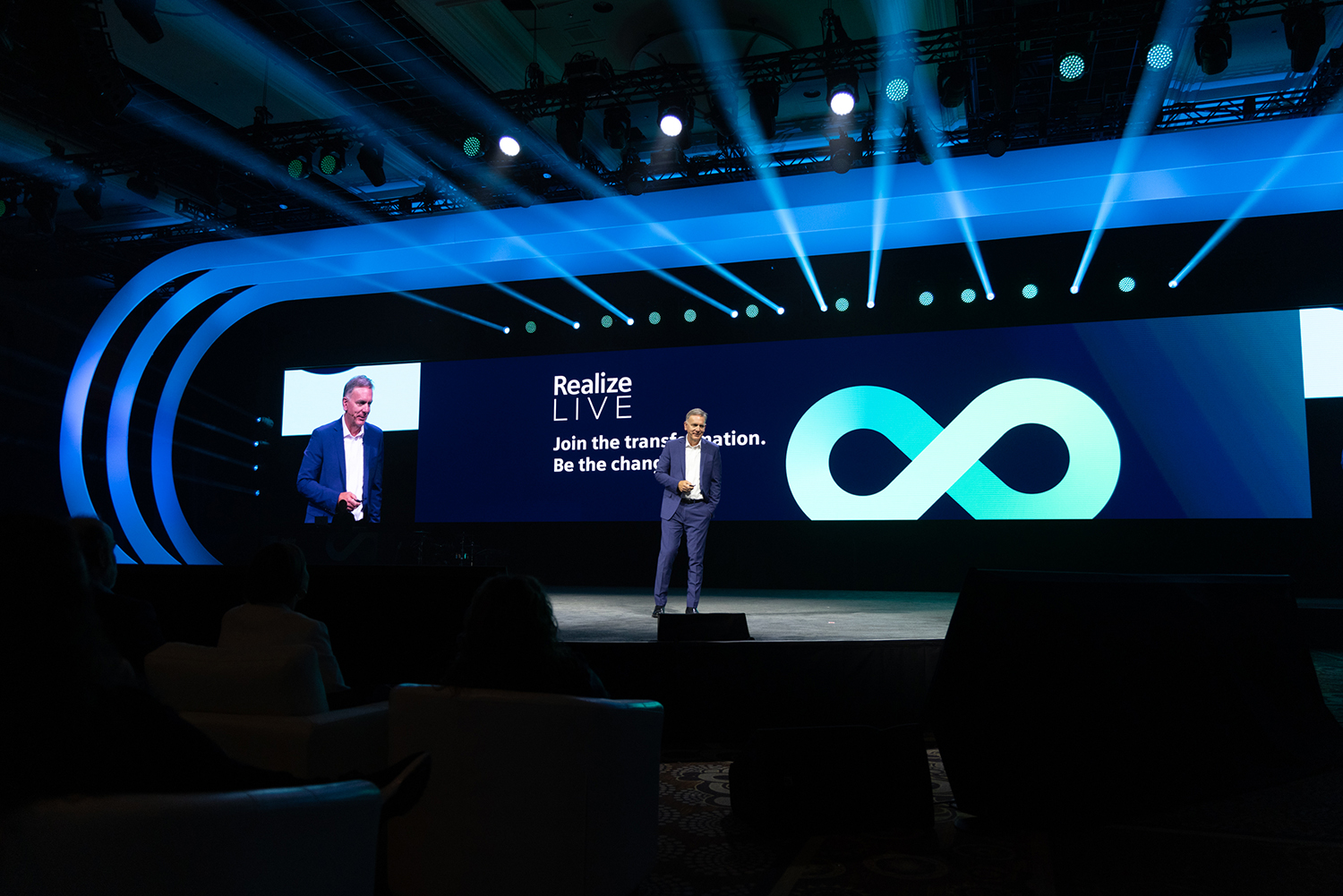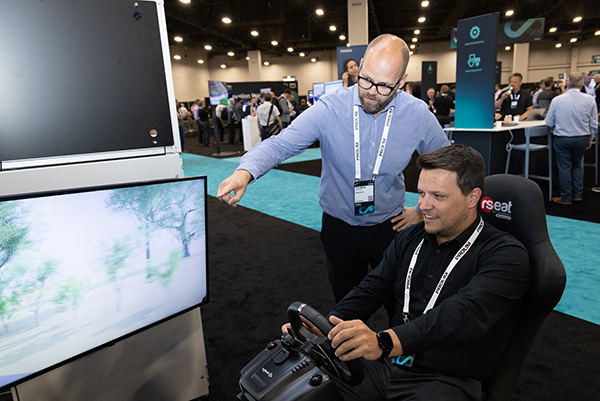
Tony Hemmelgarn, President and CEO of Siemens Digital Industries Software, discusses AI integration, on-demand HPC, and the shift to SaaS with Xcelerator portfolio in his keynote at the Siemens Realize LIVE 2023 conference. Image courtesy of Siemens.
Siemens Realize LIVE 2023: Industrial Digital Twins Built in Xcelerator
Company laid out roadmap and vision for AI integration, CO2 counting, on-demand HPC, SaaS offerings, more.
Latest News
June 21, 2023
Inside the 43-story Mandalay Bay casino and hotel, about 15 mins' walk from the roulette tables and slot machines, manufacturing titans and startups gathered to place a collective bet of a different kind. At the Siemens Realize LIVE Americas 2023 Conference, many are betting on digital twins as the future of smart manufacturing.
In his keynote, Tony Hemmelgarn, President and CEO of Siemens Digital Industries, laid out the fabric of digital twins—the digital thread. “What we mean by a digital thread is currently connected data, the information flow,” he said. “Our digital threads cover the complete flow in your large or small company, how you deal with the technology and how you bring it together.”
For Siemens, all threads come together in Teamcenter, its data management platform. “We work very hard to get on one PLM architecture, whether using Teamcenter or Teamcenter X, where you're using the Xcelerator [programs] to share, offered in the cloud, all are built with the same architecture, to offer seamless movement of data between systems,” said Hemmelgarn.
In June 2022, Siemen launched the first SaaS titles for its Xcelerator portfolio, signaling its migration to the cloud-hosted, on-demand model. The company spelled out its X roadmap: “Step-by-step, Siemens will transform its entire portfolio of hardware and software to become modular, cloud-connected and built on standard application programming interfaces (APIs),” said Siemens. The shift to the SaaS-style Xcelerator model is also a race, happening among many of Siemens' rival design and simulation software makers. PTC's acquisition of the cloud-native Onshape CAD, for example, is part of this trend.
During the conference, Siemens announced Maeve Aerospace has adopted Siemens Xcelerator to develop its next generation all-electric, zero emissions commuter aircraft.
✈️ Congratulations to Maeve Aerospace for the launch of Maeve 01 - an all-electric 44+ passenger airplane at Paris Air Show today.
We are proud to be a part of the next chapter of your story.#Simcenter #PAS2023Siemens #AviationIndustry #PAS23 #ParisAirShow pic.twitter.com/4sX1GfOu8k— Simcenter (@Simcenter_) June 20, 2023
Adding AI to the Equation
Like many other industry leaders, AI is on Hemmelgarn's mind. ChatGPT has opened a new door with its natural language processing, paving the way for a change in user paradigms in design and simulation. At Siemens, the AI-integration has already started, Hemmelgarm revealed. “We have the machine learning capability, or the technology that predicts commands based on usage and usage patterns. It allows the designers to become really proficient without years of practice. We've had this going on for the last couple of years,” he said.
In May, Siemens and Microsoft announed a partnership. “To enhance cross-functional collaboration, [we] are integrating Siemens’ Teamcenter software for product lifecycle management (PLM) with Microsoft’s collaboration platform Teams and the language models in Azure OpenAI Service as well as other Azure AI capabilities,” the companies wrote.
“[The generative AI] is automatically writing the PLC (Programmable Logic Controller) code that has to be adjusted ... So the AI is writing the code to make the change,” said Hemmelgarn. “The manufacturing engineers not only receive a notification on what's going on, but he gets direct access to the updated code. He can use it on the robot, bring it right to the edge device and upload it.”
Ravi Shanker, Director, Solutions & Technical Marketing, Siemens Digital Industries Software, said, “We have services—not commercial product yet, but for demonstration purpose—where you can interact with a ChatGPT interface to say, 'Build me a model for this purpose,' and in the background, the software works with SimCenter tools to build a model.”
Also in Simcenter HEEDS for design exploration, Shanker revealed, “We are introducing AI-based methods to speed up searching for objects through a design space. We are seeing examples where it's up to 40% faster.”
 .
.
HPC On Demand
Once enterprises move to SaaS, on-demand HPC is a foregone conclusion. In anticipation, Siemens added Simcenter Cloud HPC to its offerings in November 2022. In the announcement, Siemens said, “This service can help reduce the costs traditionally associated with on-premise high performance computing (HPC) deployment, allowing organizations of all sizes to access the benefits of advanced simulation, gain deeper insight into the performance for their products, and drive more informed engineering decision making.”
“It's part of our ongoing collaboration with AWS, the new service is hosted on AWS,” said Hemmelgarn in the keynote. The combination of on-demand HPC and SaaS, he believes, is particularly attractive to startups. Most startups, he pointed out, “didn't have an administrative team to do PLM deployment. They wanted to focus on the engineering and design, the manufacturing. [With SaaS] they didn't have to worry about all the infrastructure and everything else there.”
Another simulation software maker, Ansys, began offering on-demand HPC via Ansys Cloud Direct in February 2022. Ansys's offering is also powered by AWS.
Show Me Sustainability
Sustainability is also on Hemmelgarn's mind. He has seen his customers adopting it as one of the manufacturing requirements. “We don't believe sustainability can be a bolt-on activity. It's got to be built into the process. So it's about being sustainable and creating a better product,” he said. “It's not just in the product design. It's in supply chain interaction, services, reuse, factory automation, manufacturing, execution, all of these pieces have to be considered.”
His vision for sustainability is centered on Teamcenter, the data management hub where the bills of materials and supplier information live. “If I've got the CO2 attributes in Teamcenter, I've got the cost roll up, then I can start doing the tradeoffs between cost and CO2,” he explained.
Teamcenter now has a Carbon Footprint Calculator, ushered in by the concerns raised in the 2015 Paris Agreement. “The Teamcenter Carbon Footprint Calculator module follows the same bottom-up analysis workflow for CO2 emissions, where all relevant emission factors of the product along the value chain are summarized. This means data is collected on all emissions corresponding to direct costs (raw material, semifinished parts, machine type, energy type, tools and devices), including upstream activities for purchased parts, energy consumption, transportation and waste,” according to Siemens.
Digital Twins on the Show Floor
Many of the keynote speakers, such as Easton LaChappelle, Founder and CEO of Unlimited Tomorrow; and Brian P Carbrey, Digital Engineering Chief Architect of Boeing Defense, Space & Security, discussed the use of digital twins or digital replicas for simulation and product testing. On the show floor, Ravi Shanker, Director, Solutions & Technical Marketing, Siemens Digital Industries Software, demonstrated how digital twins might be interrogated using augmented reality apps on mobile devices.
For more on the hardware and software from the show floor, watch the video report below:
Subscribe to our FREE magazine, FREE email newsletters or both!
Latest News
About the Author
Kenneth Wong is Digital Engineering’s resident blogger and senior editor. Email him at kennethwong@digitaleng.news or share your thoughts on this article at digitaleng.news/facebook.
Follow DERelated Topics




